About Us
EXPERIENCED JOURNALISTS
The most informed, inform. Railway Age’s experienced editors—knowledgeable of the past, in tune with today and looking to tomorrow—search for answers, and get them from across the industry: management, labor, suppliers, government, the financial community, all the sources that matter. Through interviews, research, conferences and seminars, Railway Age editors raise issues and seek solutions. They ask the important questions, and get the answers that are important to our readers—a commitment, and a tradition, since 1856 (read our history, below).
William C. Vantuono, Editor-in-Chief

With Railway Age since 1992, William C. Vantuono has broadened and deepened coverage of the technological revolution that is so swiftly changing the industry. He has also strengthened Railway Age’s leadership position in industry affairs with the conferences he conducts, among them Next-Generation Train Control, Next-Generation Freight Rail, Light Rail, and Rail Insights. He is the author or co-author/editor of several books, among them All About Railroading; John Armstrong’s The Railroad: What It Is, What It Does; Railway Age’s Comprehensive Railroad Dictionary; and Planning, Engineering, Operating Light Rail, With Applications in New Jersey.
Marybeth Luczak, Executive Editor

Marybeth Luczak returned to the Simmons-Boardman Rail Group in mid-2020. Previously, she served for nearly a decade at Railway Age, working progressively from Associate to Managing to Executive Editor, covering topics such as rail and transit security, and even field-testing locomotive remote control technology. Luczak is an experienced reporter and editor whose diverse trade journalism background includes the railway, banking, magazine marketing and education industries. She holds a master’s degree from Syracuse University’s S.I. Newhouse School of Public Communications and a bachelor’s degree in English and Psychology from Fairfield University in Connecticut. (And, yes, she grew up with trains in her basement, thanks to her dad.)
Carolina Worrell, Senior Editor

Carolina Worrell returned to the editorial staff of Railway Age in June 2022 as Senior Editor following three years in the marketing group at HNTB, Boston, where she worked on such projects as the Massachusetts Bay Transportation Authority Codman Yard Expansion and Improvements and the MassDOT Office of Transportation Planning Northern Tier Passenger Rail Study. Her 15 years of journalism experience includes, in addition to Railway Age, six years at Engineering News-Record regional publications (ENR New York, ENR New England and ENR Northwest), Aviation Week, Northshore Magazine, Jazz Times and The New York Times Metropolitan Diary. Worrell earned a B.A. in Media Studies with a focus on journalism from Hunter College, City University of New York (CUNY), with a minor in English. Read stories by Worrell.
David C. Lester, Editor-in-Chief, Railway Track & Structures; Engineering Editor, Railway Age

David C. Lester has been writing about the railroad industry for more than 25 years. He studied transportation and logistics at the University of Tennessee at Knoxville and has a bachelor’s degree in economics from Georgia State University in Atlanta. David completed a career in health care information technology and consulting in 2012 and has focused on railroading full-time since then. He has written for Trains, Railfan & Railroad and other rail publications, and has contributed to two books. He served as Managing Editor of Railway Track & Structures from 2019-2022. He is a member of the Transportation Research Board and the Lexington Group in Transportation History. He specializes in technology and economic issues. Read stories by Lester
Jennifer McLawhorn, Managing Editor, Railway Track & Structures

Jennifer McLawhorn is an East Coast native and recent graduate from Old Dominion University with a master’s degree in Humanities and a bachelor’s degree in English Literature. Her earlier work dealt with interdisciplinary research across the fields of film studies and feminist theory. Having spent time in academia, she has developed her writing and editorial skills to bring with her to the publishing industry. Read stories by McLawhorn.
Kevin Smith, David Briginshaw, Robert Preston, Simon Artymiuk. Mark Simmons – International Editors

From Simmons-Boardman’s offices in Falmouth, England, International Railway Journal’s editors keep our readers abreast of offshore happenings that are of increasing importance in the U.S. IRJ, launched in 1960, started monthly publication in January 1961 as the world’s first globally distributed magazine for the railway industry. IRJ is written for senior managers and engineers of the world’s railways and transit systems, ministers of transport, manufacturers, railway planners, and consultants. It is produced by a well-respected team of journalists and correspondents with an intimate working knowledge of the industry. IRJ editors travel the world to bring discerning readers the latest developments in rail transport, setting a high standard for quality editorial content. Kevin Smith is IRJ Editor-in-Chief. David Briginshaw is Consulting Editor/Associate Publisher. David Burroughs is News Editor. Robert Preston is Associate Editor. Simon Artymiuk is News Reporter. Mark Simmons is Deputy Editor. Read stories by Smith. Read stories by Briginshaw. Read stories by Preston. Read stories by Artymiuk.
David Nahass, Financial Editor

An authority on all areas of railroad equipment finance and leasing, David Nahass writes our monthly Financial Edge column and produces our annual Railroad Financial Desk Book and Guide to Equipment Leasing. He is President of Railroad Financial Corp., a financial advisory firm. He also serves as Chairman of Rail Equipment Finance, an annual industry conference addressing critical developments concerning North America’s railcar and locomotive fleet. Read stories by Nahass.
Heather Ervin, Ports and Intermodal Editor

Heather Ervin, Editor-in-Chief of Simmons-Boardman’s Marine Log, joined the publication in April 2019. For Railway Age, she will provide content relating to rail-served ports and intermodal services. Previously, Heather was Associate Editor of inland river trade magazine The Waterways Journal for more than six years. At Marine Log, she has combined her experience with the inland marine industry with the magazine’s broader audience, which also includes coastal, offshore and international shipping, to ensure a more robust coverage of the entire maritime market. Heather has more than a decade of reporting, writing and editing experience from a variety of newspaper and trade magazine publications. She graduated with honors from the Missouri School of Journalism at the University of Missouri in Columbia, one of the oldest formal journalism schools in the world.
Nick Blenkey, Senior Editorial Consultant and Web Editor, Marine Log

A native of the United Kingdom, Nick Blenkey is an experienced journalist who has been reporting and writing on maritime topics for more than four decades. He was first associated with Simmons-Boardman’s Marine Log as its European Editor, based in London. In the early 1980s, he moved to New York City to become Editor-in-Chief of Marine Log. He is now the publication’s Senior Editorial Consultant and Web Editor, contributing news and feature stories to the publication’s website, www.marinelog.com.
David Peter Alan, Contributing Editor

David Peter Alan is a long-time passenger rail advocate. He is Chair of the Senior Citizens and Disabled Residents Transportation Advisory Committee (SCDRTAC) at New Jersey Transit, and Chair of the Essex County Transportation Advisory Board. Nationally, he belongs to the Rail Users’ Network (RUN). Admitted to the New Jersey and New York Bars in 1981, he is a member of the U.S. Supreme Court Bar and a Registered Patent Attorney specializing in intellectual property and business law. Alan holds a B.S. in Biology from Massachusetts Institute of Technology (1970); M.S. in Management Science (M.B.A.) from M.I.T. Sloan School of Management (1971); M.Phil. from Columbia University (1976); and a J.D. from Rutgers Law School (1981). Read stories by Alan.
Jim Blaze, Contributing Editor

Independent railway economist Jim Blaze has been in the railroad industry for well over 40 years. Trained in logistics, he served seven years with the Illinois DOT as a Chicago long-range freight planner and almost two years with the USRA technical staff in Washington, D.C. Jim then spent 21 years with Conrail in cross-functional strategic roles from branch line economics to mergers, IT, logistics, and corporate change. He followed this with 20 years of international consulting at rail engineering firm Zeta-Tech Associates. Jim serves as Second Vice-Chair of the Senior Citizens and Disabled Residents Transportation Advisory Committee (SCDRTAC) at New Jersey Transit. He is a Magna cum Laude Graduate of St. Anselm’s College with a master’s degree from the University of Chicago, Married with six children, he lives outside of Philadelphia. “Writing for Railway Age reflects my continued passion for the future of railroading as a competitive industry,” says Jim. “Only by occasionally challenging our institutions can we probe for better quality and performance. My opinions are my own, independent of Railway Age.” Read stories by Blaze.
Sonia D. Bot, Contributing Editor

Sonia Bot, chief executive of The BOT Consulting Group Inc., has played key roles in the inception and delivery of several strategic businesses and transformations in technology, media and telecommunications companies worldwide. By utilizing methodologies in entrepreneurship, business precision, Lean Six Sigma, system and process engineering, and organizational behavior, she’s enabled organizations to deliver breakthrough results along with providing them a foundation to continue to excel. Sonia’s contributions to the rail industry are as a leader and a visionary who is passionate in taking railroading into the next generation. Within the Digital Business Transformation context, she leads high-stakes mandates where new business models are created and enabled by digital technologies. She was instrumental in PTC implementation on CN’s U.S. lines. Her approaches on the evolution of railroading and transportation are game-changers that drive innovation and competitive advantage for adopters in a changing industry. Sonia can be reached at [email protected]. Read stories by Bot.
Robert H. Cantwell, Contributing Editor

Principal of Rail Supply Chain Associates, Robert H. Cantwell spent more than 40 years in executive positions in the rail supply industry. He spent the first 26 years of his rail industry career growing a successful company, Hadady Corp., a designer and manufacturer of truck (bogie) components and systems for locomotives and transit railcars. Following the sale of his business, Bob helped transform Amsted Rail, holding various executive positions for 16 years. He has been active in the Rail Transportation Division of the ASME (American Society of Mechanical Engineers) and is past Chairman of the Division. Bob holds degrees in Mechanical Engineering from the Georgia Institute of Technology and an MBA from the University of Chicago. He possesses a unique perspective on the rail supply industry, combining his engineering experience along with robust economic and financial acumen. As an active investor in the rail industry, he has a vested interest in the success of the industry. He has also actively advocated with members of Congress in support of the rail and rail supply industry. Read stories by Cantwell.
Afred E. Fazio, P.E., Contributing Editor

Alfred E. Fazio has 40 years experience in freight and passenger rail. He retired from Amtrak as Deputy Chief Engineer, where he was responsible for the implementation of high-speed rail improvements to the Northeast Corridor. Prior to this, he was General Manager of New Jersey Transit’s Camden to Trenton RiverLINE diesel light rail system. He also served with Raytheon and Washington Group International as President of Twenty-First Century Rail, the DBOM supplier of the NJ Transit Hudson-Bergen Light Rail system. From 1989 through 1996, Fazio was Amtrak’s Division Engineer for the New York Division. He holds a bachelor’s degree in Civil Engineering from Villanova University, a master’s in Environmental Engineering from Drexel University, a master’s in Applied Mechanics from the University of Pennsylvania, and is a registered Professional Engineer. He is a member of the American Railway Engineering and Maintenance-of-Way Association (AREMA) as well as the American Institute of Aeronautics and Astronautics (AIAA). Fazio has also served as a member of the Engineering faculty at the U.S. Naval Academy and at Widener University. He has been a featured presenter at Railway Age’s annual Light Rail Conference. Among his books are Development and Operation of New York’s IRT and BMT; River LINE – Southern New Jersey’s Interurban Railway; The BMT – A Technical and Operational History; and Elements of Planning, Engineering and Operating Light Rail, With Applications in New Jersey. Read stories by Fazio.
Gary Fry, Ph.D., P.E.

Dr. Fry is Vice President of Fry Technical Services, Inc. He has 30 years of experience in research and consulting on the fatigue and fracture behavior of structural metals and weldments. His research results have been incorporated into international codes of practice used in the design of structural components and systems, including structural welds, railway and highway bridges, and high-rise commercial buildings in seismic risk zones. He has extensive experience performing in-situ testing of railway bridges under live loading of trains, including high-speed passenger trains and heavy-axle-load freight trains. His research, publication, and consulting have advanced the state of the art in structural health monitoring and structural impairment detection. Read stories by Dr. Fry.
Michael Iden, P.E., Contributing Editor
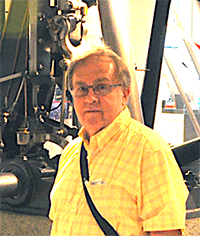
The career of Michael Iden spans 50 years including positions at Southern Railway (management trainee, Engineering & Research), GM-EMD (locomotive and engine manufacturing), C&NW (AVP-Motive Power) and Union Pacific (Senior Director Locomotive Engineering). He is a registered professional engineer in three states and was an FRA-licensed locomotive engineer at C&NW and UP (he never worked as a locomotive engineer but believes those who acquire and maintain locomotives should fully understand their use). After retiring from UP in 2018, Iden began consulting as Tier 5 Locomotive LLC (registered in 2013 “… before emissions Tier 4 became law …”) and serves clients particularly in the railroad and locomotive industries, focusing especially on emissions, decarbonization and managing the introduction of new technologies. He has served as chair of numerous AAR Committees including the first chairmanship of the Coupling Systems & Truck Castings Committee in 2004, is an Advisory Trustee for Southwest Research Institute in San Antonio, Tex., and has been a guest lecturer for Michigan State University. Iden has a BSME from the Milwaukee School of Engineering and a Master of Management degree from Northwestern University, is married with two children and lives in Illinois. The opinions expressed are his own, independent of Railway Age. Always remember Putt’s first law of invention: “An innovated success is as good as a successful innovation.” Read stories by Iden.
Donald M. Itzkoff, Contributing Editor

Donald M. Itzkoff, a former FRA Deputy Administrator for five years in the Clinton Administration under Transportation Secretaries Federico Peña and Rodney Slater, is Chief Policy Officer of Patriot Rail. He is also founder of Transport Strategies, a global government affairs and policy firm in Washington D.C. Itzkoff was Vice President Government Relations and Public Affairs for Wabtec; prior to joining Wabtec, he led GE Transportation North American government affairs for seven years. Itzkoff earlier served as Senior Majority Counsel to the Senate Commerce Subcommittee on Transportation and Safety. He received his J.D. from the University of Michigan Law School and his A.B. magna cum laude from Brown University. He is book author and a member of the Board of Directors of the Center for Hearing and Communication, New York, N.Y. A frequent contributor and conference speaker over the years, Itzkoff began his association with Railway Age in the 1980s with his own column, High Speed Currents. Read stories by Itzkoff.
Bruce Kelly, Contributing Editor

Bruce Kelly has produced photography and journalism for rail publications since 1982, with more than 120 feature articles and hundreds of news stories, reviews, and editorial commentaries to date. Nearly 2,000 of his photographs have appeared in railway magazines, books, calendars, annual reports, and advertising. He was Associate Editor of Railfan & Railroad from 1988 to 1996. Since 1996, he has worked in the digital prepress department of Idaho’s largest commercial printing company. Over the past 30 years, Kelly’s photography has been frequently featured on the front cover and inside pages of Railway Age. Read stories by Kelly.
Ron Lindsey, Contributing Editor

Ron Lindsey is an independent consultant in the rail and intermodal industries. He began his career with IBM in 1970. He subsequently joined the Trustee Staff of the Penn Central bankruptcy and has spent the past 40 years in railroad management and independent consulting. He was Chief Engineer Communications at Conrail and Director of Advanced Train Control at CSX. At CSX, his primary responsibility was to conceive and manage the development of the first overlay PTC system that is the basis for those systems being deployed to meet the federal mandate. Additionally, he conceived and managed the design of an advanced train control/management system, Virtual CTC, for the railroads of Egypt and Kazakhstan. In addition to providing strategic technology planning sessions and market studies, Lindsey offers a suite of courses on conventional and advanced railroad operations based upon advancing technologies that are used by railroads, suppliers, and Professional Engineers to satisfy their on-going education credits. Read stories by Lindsey.
Joanna Marsh, Contributing Editor

Joanna Marsh is an award-winning journalist and writer who relishes taking complex subjects and making them easier to understand. Her stories on the possibility of a national freight railroad strike in December 2022 earned a silver award in the Southeast region from the American Society of Business Publication Editors. Joanna headed U.S. and Canadian freight rail coverage at FreightWaves, an online news publication on freight transportation, for nearly five years. Prior to that, she served as a freelance reporter for Argus Rail Business writing features on the North American freight railroads. Joanna double majored in music and political science at Barnard College, and she has a master’s in journalism from Boston University. She likes hearing the occasional train horns of CSX in the Washington, D.C. suburbs where she lives, as well as those of Norfolk Southern near her mother-in-law’s house in Knoxville, Tenn. She has even run out of restaurants multiple times to take photos of NS trains going by in case she ever needs one to accompany a story. Read stories by Marsh.
Jason H. Seidl, Wall Street Contributing Editor

Transportation analyst Jason Seidl, Managing Director, Industrials – Airfreight & Surface Transportation at TD Cowen, a Division of TD Securities in New York City, lends his unique insights to Railway Age through his timely editorials. He has been recognized for stock-picking and earnings accuracy by several nationwide analyst surveys. Seidl joined TD Cowen in 2013 as part of the acquisition of Dahlman Rose and covers air freight and surface transportation. Prior to joining Dahlman Rose in 2008, he spent nine years on Wall Street following freight transportation companies. Seidl also spent more than four years working in trucking/parcel transportation. He has a bachelor of science degree in transportation distribution management from Syracuse University and a master’s of business administration from Rutgers University. He is a member of the executive advisory board for Syracuse University’s School of Supply Chain Management, and a member of the board of directors for the North East Association of Rail Shippers (NEARS), for which he recently served as President. Read stories by Seidl.
Ron Sucik, Contributing Editor

As Director, Market Development at TTX, Ron Sucik established relationships in the industry that include members of the railroads, steamship lines, port authorities, transloaders, 3PLs, motor carriers, intermodal marketing companies, retail industry and real estate development companies. Ron is recognized as having a significant understanding of the trends of trade flows into North America and the affect they have on the rail industry. He is often called upon for his perspective of emerging issues. Ron’s prior experience at Burlington Northern gave him an understanding of the basic operational aspects of the rail side of the intermodal industry as well. He holds a Bachelor of Science in Business Administration and an MBA with emphasis on Marketing from Illinois Benedictine University. Ron remains active within the transportation community as a consultant. He was a major contributor to the CIGMA International Freight Study at the Tioga Group, and continues to make presentations on the issues and trends in the intermodal industry. Ron and his wife Robin live in Naperville, Ill. Read stories by Sucik.
David Thomas, Canadian Contributing Editor

David Thomas is a reporter who has covered government and society since graduating from Ottawa’s Carleton University with degrees in political science and journalism. He has written for National Geographic, Maclean’s, The Globe and Mail, The Gazette, and The Canadian Press news agency from postings in Ottawa, Montreal, Quebec City, Toronto, and London, England. “Railroading has been a personal fascination since a childhood timed fortunately enough to witness the golden years of steam on the late-to-dieselize Canadian National and Canadian Pacific,” he says. Read stories by Thomas.
John Thompson, Canadian Contributing Editor

John Thompson was born and grew up in Toronto, and studied journalism at the University of Toronto and, later, creative writing at Ryerson University. He joined the senior staff of the Toronto Transit Commission in 1977, subsequently becoming assistant editor of Coupler, the TTC’s employee magazine, as well as performing public relations and archival duties. Thompson has been a freelance writer and editor for 20 years, for the Toronto Star newspaper and numerous trade publications, including Railway Age. He resides in Hamilton, Ontario. Read stories by Thompson.
Frank N. Wilner, Capitol Hill Contributing Editor

Frank N. Wilner is author of six books, among them Amtrak: Past, Present, Future; Understanding the Railway Labor Act; and Railroad Mergers: History, Analysis, Insight. He earned undergraduate and graduate degrees in economics and labor relations from Virginia Tech. He has been assistant vice president policy for the Association of American Railroads; a White House appointed chief of staff at the Surface Transportation Board; and director of public relations for the United Transportation Union. He is a past president of the Association of Transportation Law Professionals. Wilner drafted the railroad section of the Heritage Foundation’s Mandate for Change (Volumes I and II), which were policy blueprints for the two Reagan Administrations; and was a guest columnist for the Cato Institute’s Regulation magazine. Read stories by Wilner.
Tony Zenga, Contributing Editor

Tony Zenga, owner of CMTIGroup Inc., is an accomplished specialty engineering consultant with international experience in operational reliability and safety for mission critical systems. He has played key roles in the implementation of System Safety engineering programs for aerospace, defense, high tech, mass transit and rail infrastructure projects worldwide. By leveraging his design and development experience of large-scale safety-critical systems, combined with his systems engineering knowledge, he enables organizations to deploy their systems safely into field operation. As advisor to CN, he was instrumental in the development of the PTC system safety engineering safety case and the creation of the system safety engineering discipline. Tony can be reached at [email protected]. Read stories by Zenga.
History of Railway Age
By Editor-in-Chief William C. Vantuono
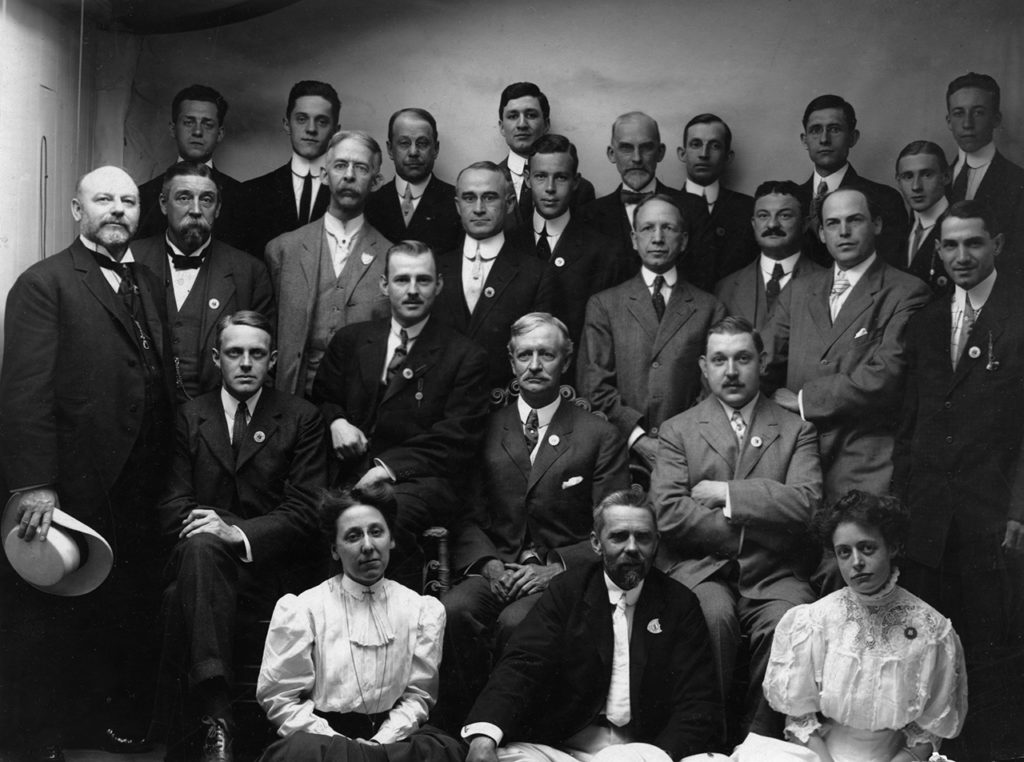
What purpose does a trade publication serve? One of Railway Age’s earliest editors put it this way: “It may be true that experience is the best teacher. But a man is a damned fool who cannot learn from anybody’s experience but his own.”
As for a trade publication serving the railway industry, another early Railway Age editor said something his successors try their best to uphold: “If we shall succeed in producing a railway journal comprehensive without diffusiveness, practical without dryness, solid without heaviness, and of value both to those who build and operate our railroads, and those who use them, we shall feel assured of abundant success.”
The publication known today as Railway Age began life in 1856 as The Western Railroad Gazette. It became known as The Railroad Gazette in 1870, and underwent a major name change in 1908 after purchasing its chief rival, The Railway Age, which had been founded in 1876. The merged magazines were initially published as The Railroad Age Gazette. In 1909, the name was changed to The Railway Age Gazette, and finally, in 1918, to Railway Age.
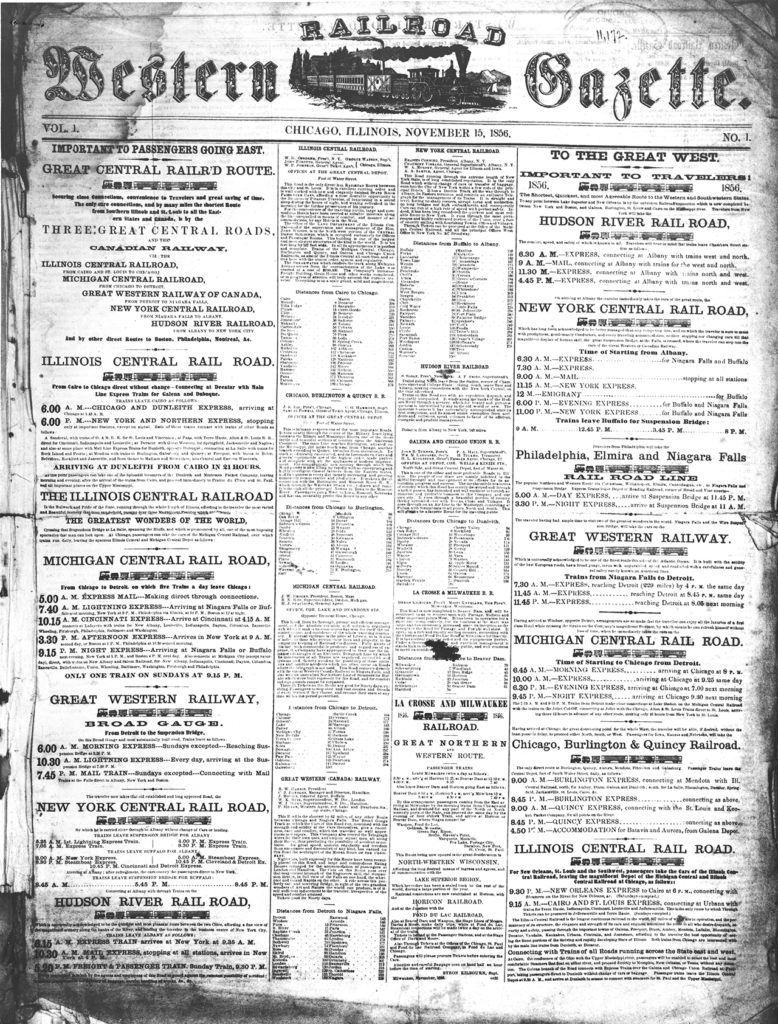
There have been other mergers and acquisitions over the years that collectively have shaped our history. In every case, the surviving name was Railway Age.
Prior to its merger with The Railroad Gazette in 1908, The Railway Age merged with The Northwestern Railroader, founded in 1887. The magazine was called The Railway Age & Northwestern Railroader until May 1901, when it reverted to The Railway Age. In later years following the Railroad Gazette/Railway Age merger in 1908, there were two significant acquisitions. In 1927, Railway Age absorbed The Railway Review, which had been founded in 1868 as The Chicago Railway Review. In 1991, Railway Age absorbed Modern Railroads, which had been established in 1946.
Those are the major pieces of Railway Age’s lineage. However, within our bloodstream flow the elements of several more publications, most of them monthly or semi-monthly companion technical publications devoted to specific industry disciplines. The oldest of these is the American Rail-Road Journal, founded in 1832 as the very first railway trade publication. It became the American Engineer & Railroad Journal in 1886, and then Railway Mechanical Engineer in 1911, when it was purchased by Simmons-Boardman Publishing Corp., Railway Age’s parent company. Before being folded into Railway Age in 1975, it was known as Railway Locomotives & Cars.
Railway Signal Engineer, founded in 1907, was purchased by Simmons-Boardman in 1910. It later became Railway Signaling & Communications and was last published in 1975 as Railway System Controls. The Railway Age family at one time also included Railway Purchases & Stores, last published in 1967; Railway Electrical Engineer, last published in 1942; and Railway Freight Traffic, last published in 1958. Simmons-Boardman continues to publish Railway Track & Structures (RT&S), which was founded as Railway Engineering & Maintenance in 1905. RT&S stands on its own mostly because an industry that invests the bulk of its capital dollars in infrastructure can support a specialized publication.
International Railway Journal (IRJ), founded in 1960, is a sister publication based in Britain. Here, there is an interesting history: In 1904, the publisher of The Railroad Gazette, believing that through a U.S.-owned magazine published in Britain, much could be done to extend U.S. railroad practices abroad and increase the sale of U.S.-made railway equipment and supplies, bought Transport of London, a weekly devoted to transportation on both land and water. Under the name Railway Gazette, a policy of very gradual Americanization was started, but after a few years’ trial the policy was abandoned as unsound and the magazine was sold to the individuals who had been publishing it in Britain. Today, Railway Gazette survives as a principal competitor of its distant cousin, International Railway Journal (IRJ).
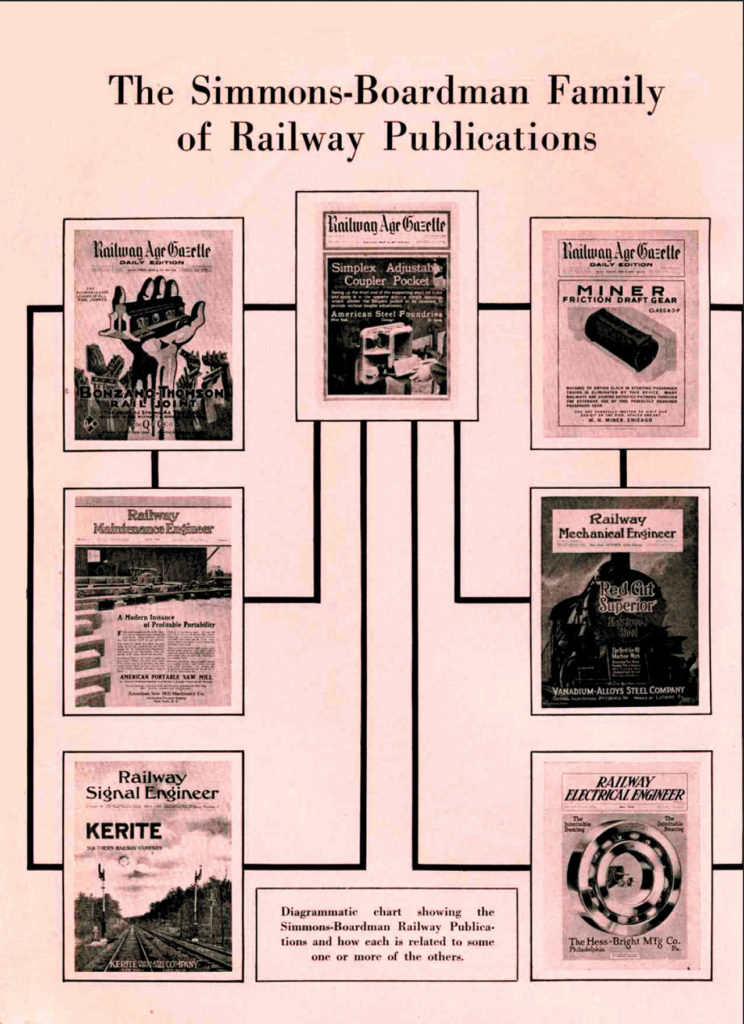
Back to the beginning: The Western Railroad Gazette was a very different publication from its descendants. It was founded at the Chicago Tribune as a publicly circulated periodical, not a trade publication. “It wasn’t much of a paper, to put it bluntly,” wrote the editors in Railway Age’s 1956 centennial issue. “It was not a business paper at all, in fact. It didn’t do a business paper’s job. It was not addressed primarily to the men who run railroads. There was not a line in its four littered pages that would help them build or run railroads better. Its audience was the public at large—chiefly the traveling public, and probably largely commercial travelers—most of whom got the paper free. Its chief advertisers were railroad companies. Other products and services hawked in its columns included hotels, clothing, patent medicines, tobacco, jewelry, banks, business schools, and stock brokerage. The editorial pages contained little of serious import to railroad men. They comprised mostly endless praises of the routes and services of the railroads that advertised, and horrendous tales of accidents, lateness, rudeness, and discomfort in the cars of their non-advertiser rivals.”
That changed in 1870 when W. N. Kellogg bought the paper and renamed it The Railroad Gazette. Kellog wanted the Gazette to be “a complete repository of railroad news,” including “descriptions of engineering works and improvements in machinery and rolling stock … We shall not be satisfied unless and until The Railroad Gazette is made an effective instrument for elucidating the science and perfecting the art of transportation; not by suggestions or instructions of its conductors, so much as by the teachings and discussions by practical railroad men given in its columns.”
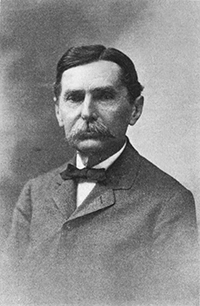
The Railroad Gazette almost came to an end in the great Chicago fire of 1871, which destroyed most of its assets. Kellog had other business interests, all of which were affected by losses suffered in the fire. He sold what remained of the paper to Silas W. Dunning and Mathias N. Forney, who moved it to New York City and probably did more than anyone else to put the publication on the path to longevity. Dunning, editor from 1871 to 1887, shaped the Gazette into a publication with a positive influence on railroad practice and legislation. Forney, a mechanical engineer, was the magazine’s engineering and mechanical editor until 1883. He was a founder of the American Society of Mechanical Engineers and the Master Car Builders Association. He was also a member of an MCBA committee that prepared a dictionary of carbuilding terms. The book, published by The Railroad Gazette, was the forerunner of the Car Builder’s Cyclopedia, later the Car & Locomotive Cyclopedia, the most recent edition of which was published in 1997 by Simmons-Boardman Books.
Silas Dunning’s successor as The Railroad Gazette’s editor in 1887 was Henry G. Prout, a civil engineer credited with influencing the U.S. Senate to select Panama, not Nicaragua, as the site of a canal linking the Atlantic and Pacific oceans—today’s Panama Canal. Prout retired from The Railroad Gazette in 1903 to become vice president and general manager of Union Switch & Signal Co.

The Railroad Gazette, Railway Age said in 1956, “fought fearlessly for what it thought to be right. Frequently it criticized the industry upon which it depended for its life, in a manner that no business paper today would dare. It castigated individual railroads—by name—for what it considered gross negligence in providing crossing protection or block signals, and did not fear, for example, to call the powerful Vanderbilts (New York Central & Hudson River Railroad) ‘life-risking penny pinchers’ for not so protecting their properties. Week after week, it told stories of loss of life caused by continued use of link and pin couplings and old-fashioned ‘man-killing’ buffers, and kept up the barrage until the automatic, vertical plane coupler was adopted. It scolded top management for not paying its operating officers more generously. If it did not encourage the formation of the [labor unions], it did not oppose them; and frequently took the side of rank-and-file employees in disputes—especially when safety or good service were at stake. It kept pounding at the necessity for railroad officers to find facts, and not rely on hunches and ‘things they learned while young that are no longer so.’ Why was The Railroad Gazette so bravely outspoken? Probably because it grew up when there was no regulation of railways—when they were a monopoly, and before they understood the public interest. The only regulation in the country was that provided by The Railroad Gazette itself.”
Perhaps the best example of The Railroad Gazette’s influence was the “battle of the gauges.” During the early 1870s, heated debate occurred over whether a single track gauge or a variety would prevail. “Standard” gauge (4 feet, 8-1/2 inches) or “broad” gauge (5 feet) were advocated for heavy traffic main lines—and a 3 foot 6 inch gauge for light-density lines. The magazine’s campaign for the industry to adapt the prevailing standard gauge emphasized the lack of economic justification for narrow-gauge lines and the need for a single gauge “to avoid the strangulation of commerce in a rapidly growing nation of vast territorial extent.”

William H. Boardman, who had joined The Railroad Gazette in 1869 and had become part owner and president by 1883, succeeded Prout as editor. Boardman’s strengths, however, were more in line with the business side of publishing. In 1908, he and E. A. Simmons, The Railroad Gazette’s vice president of advertising, established the Simmons-Boardman Publishing Corporation with the intent of purchasing The Railway Age, which they considered The Railroad Gazette’s strongest competitor. The $265,000 transaction merging the two rival publications took place in June of that year.
Boardman remained as editor of the new Railroad Age Gazette until 1911, when he retired and was succeeded by Samuel O. Dunn, who had been The Railway Age’s managing editor at the time of the merger. Dunn was initially appointed western editor of Railroad Age Gazette. He changed the name of the publication to Railway Age Gazette in 1909, and in 1918, he simplified it to Railway Age.
The Railway Age had been founded by George S. Bangs, Charles F. Hatch, and E. H. Talbott in Chicago in June 1876. Its headquarters were located at the Grand Pacific Hotel Building. Bangs had been superintendent of the United States Railway Mail Service. Besides founding The Railway Age, his claim to fame was establishment of Fast Mail trains. The Railway Age defined its readership as railroad managers and investors and its natural source of advertising as railroad suppliers, though it also accepted advertising from the railroads.
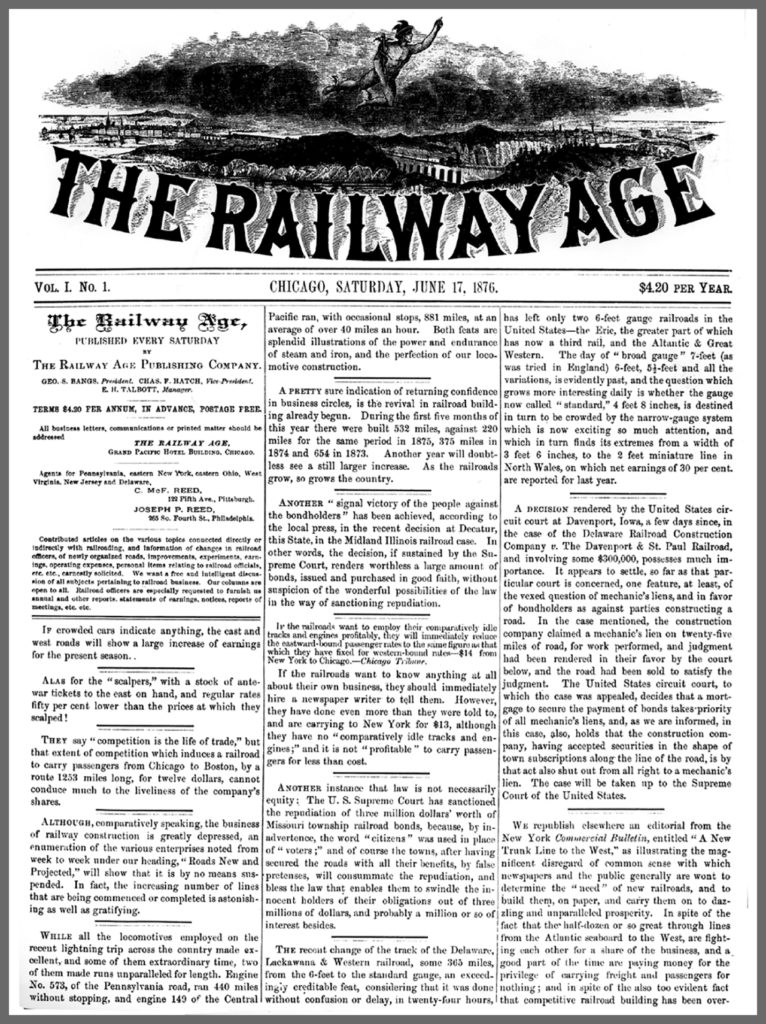
The Railway Age was much different in character than The Railroad Gazette. It “was not then as vocal as to its objectives, but it became a lively chronicler of events and developments in the railway field,” as Railway Age described it in 1956. “Its tone was lighter than that of its older rival. It dealt less consciously with the science and art of conducting transportation and leaned more to the business aspects of railroad management. It was edited for other employees of the railroads as well as officers. It attracted a large volume of advertising.”
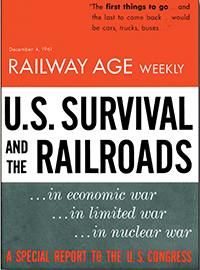
Why did Simmons and Boardman want to acquire The Railway Age? “While, prior to the merger, The Railroad Gazette had the greater prestige, it was losing ground in circulation and in advertising to its livelier, more enterprising Chicago rival,” Railway Age noted in 1956. “Boardman himself admitted that The Railroad Gazette was ‘edited for student railroad presidents and there were never enough of them.’” The combined magazine “reflected the character of both ancestral lines. It continued the Age’s alertness to the news of the industry. It continued the thorough exposition and interpretation of technical aspects of railroad operation that it had inherited from the Gazette. Altogether, it was a stronger paper than either and began at once a steady climb in circulation and advertising revenues. Starting out with about 4,000 subscribers on the Gazette and the Age apiece (many of which were duplicated), it pushed circulation to 10,000 by 1929—despite its policy of limiting promotion of sale of the paper to readers of railway officer status.”
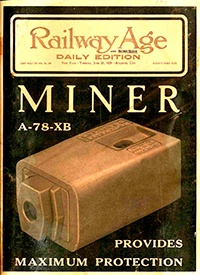
Samuel O. Dunn in 1911 was the highest paid business paper editor in the United States, with the largest editorial staff of any technical journal. He introduced “what was then a new attitude toward editorial staffs,” as we reported in 1956. “Although he had himself neither technical nor railroad experience, he chose as his editors men who had received technical education in leading universities and who had had railroad experience.” For example, Roy V. Wright, who reported on mechanical subjects besides serving as managing editor, had been mechanical engineer of the Pittsburgh & Lake Erie and was regarded as a national authority on shop techniques. He was president of the American Society of Mechanical Engineers in the 1930s.
“When Dunn took over, railway papers in general were almost exclusively technical. Having made himself a recognized authority on regulatory problems, he concluded that railways were confronted with a problem that surpassed all their technical difficulties—namely, public ill will, evidenced by bitter attacks upon them, even by business interests, and by crippling regulation. He therefore broadened the paper’s scope and began to hammer home forcefully the evil effect of bad railroad regulation and government ownership (which occurred during World War I with the United States Railroad Administration). These arguments were given wide distribution in the daily press. At the height of this activity, it was reckoned that papers with a combined circulation of more than four million were regularly printing items quoted from Railway Age or its editor.”
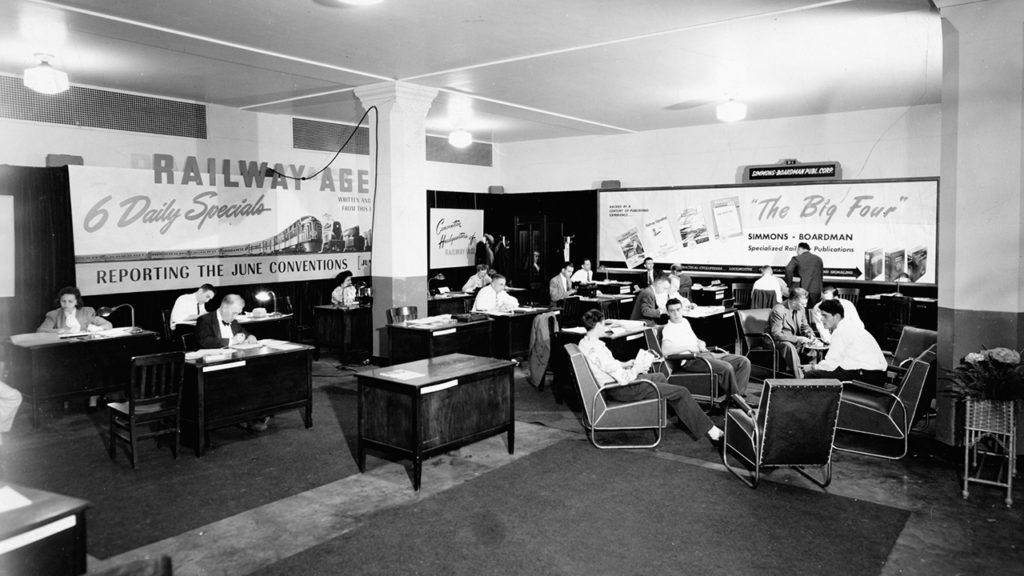
It is widely believed that Railway Age did much to chronicle the ills of government ownership and helped return control of the railroads to their owners in 1921.
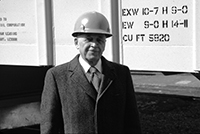
1912 marked a major turning point in the fortunes of Simmons-Boardman Publishing Corp. and set the company on a course to its present form. Simmons bought out Boardman’s holdings and became the owner of a majority of the company. Simmons, who died in 1931, extended the company’s properties to include trade publications in other industries. Active direction of the company passed to Dunn, chairman of the board. Upon Dunn’s retirement in 1950, James G. Lyne, who had been co-editor of Railway Age for two years, became editor as well as president of Simmons-Boardman. In 1954, controlling interest in the company was sold to a group of long-time employees, and Railway Age and its sister magazines became owner-operated properties. The principal stockholders were Lyne and Executive Vice President Arthur J. McGinnis Sr., both of whom started with the company as associate editors of Railway Age (McGinnis in 1940). Robert G. Lewis, who had joined Railway Age in 1947 as associate editor, was named publisher of the company’s railway group in 1956.
Today, Simmons-Boardman is owned by the McGinnis Corp., whose Chairman, President, and CEO is Arthur J. McGinnis Jr.
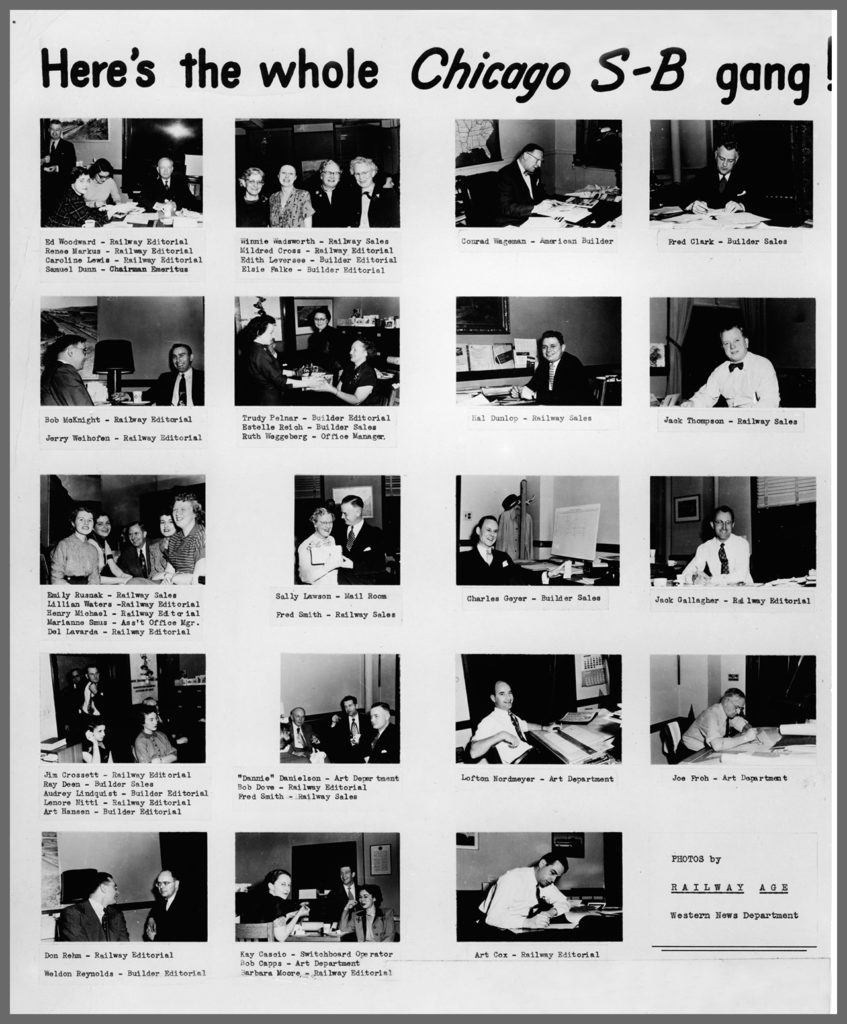
In many ways, Railway Age’s fortunes have followed those of the railroads. In the early 20th century, some railroads had bigger budgets and employed more people than the federal government. Reflecting the industry’s character at the time, Railway Age was the world’s largest periodical in sheer physical size, with some single issues containing 200, 300, or even 400 or more editorial and advertising pages. Our editors traveled in the magazine’s own business car, the first built by Pullman for a non-railroad company.

Its early appearance on the scene gave Railway Age many business publication “firsts.” In the 1880s, it was the first periodical to operate a permanent exhibition center for advertisers, at Chicago’s Grand Pacific Hotel. In 1909, during the magazine’s campaign to have the railroads pay more attention to the public, Railway Age became the first periodical anywhere to define and use the term “public relations.” It was the first weekly business periodical in the U.S. to publish daily editions during industry conventions, and the first technical publication serving a single industry to use photo engravings. In 1881, it was the first technical publication to use color on editorial pages. In 1886, it was the first technical publication to use color on advertising pages, for the Westinghouse Air Brake Company.
Perhaps most important, in 1916, Railway Age was the first single-industry weekly to open an editorial office in Washington D.C. and put a full-time staff editor in charge. In the 1930s, Railway Age was the only trade publication with full White House accreditation.

Such close ties to the railway industry had its downsides. For example, much of Railway Age’s early prosperity was built on the steam locomotive. Most steam locomotives were custom-built, using parts offered by many competing suppliers, and much of the competition for this business took place through advertising in the magazine. Is it any wonder that the magazine was not one of the early enthusiasts of essentially off-the-shelf diesel-electric locomotives?
Railway Age’s connection to the industry’s fortunes became painfully clearer in 1970, when the gradual decline in traffic and profitability with which the railroads had been dealing for years under the burden of over-regulation—which, in turn, hurt suppliers—prompted its shift from a weekly to a twice-monthly publication. The industry was in the beginning stages of a long period of consolidation, and suppliers were becoming fewer in number.
Partial deregulation of the railroads under the Staggers Act of 1980, and the efficiencies the railroads were able to employ following this landmark piece of legislation, led in no small way to Railway Age’s 1983 shift to a monthly. “Our new publishing frequency makes sense both editorially and from a business standpoint,” we said. “It lets us move and respond in the marketplace just as railroads are now moving, responding and growing.”

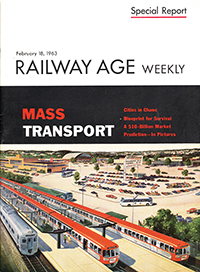
But change can also mean growth. Railway Age was for many years devoted almost entirely to freight and main line passenger railroads. That changed in 1963, when the first issue of Railway Age devoted to rail transit was published. Today, we consider coverage of this important industry segment one of our biggest assets.
We have also attracted our share of controversy. Railway Age in 1959 was accused of steering the industry toward socialism by suggesting that railroads needed to be indemnified by government for the huge losses they incurred operating commuter trains for “the public convenience and necessity.” The president of the Illinois Central Railroad threatened to boycott the magazine’s advertisers in its pages. Interestingly, it was this railroad that was among the first to line up for federal aid when it became available in the 1960s.
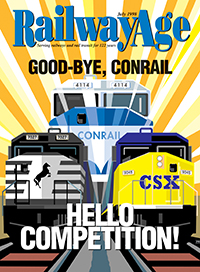
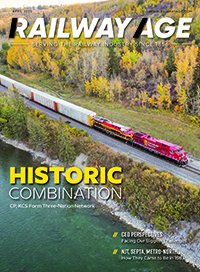
In addition to helping the U.S. railway industry fight off nationalization in the early 1920s and again in the 1960s, Railway Age is credited with aiding the industry in two other monumental battles: against federal regulation that paralyzed the entrepreneurial spirit, drove many railroads into bankruptcy, and came close to pulling down the whole industry; and against anachronistic work rules that penalized railroad labor in lost jobs and railroad management in lost productivity.
Today, as an efficient and profitable railroad industry deals with the promises and pitfalls of renewed strength, relevance and market power, Railway Age continues its role in serving the industry. We embraced the shift to electronic publishing and social media that has fundamentally changed the way information is gathered and disseminated. Our website reports industry breaking news and offers commentary. A daily electronic newsletter, Rail Group News, incorporates content from Railway Track & Structures and International Railway Journal. All three titles are published monthly in digital as well as print format. Video productions became part of our repertoire around 2010, and in 2020, we added Rail Group On Air podcasts to our portfolio.